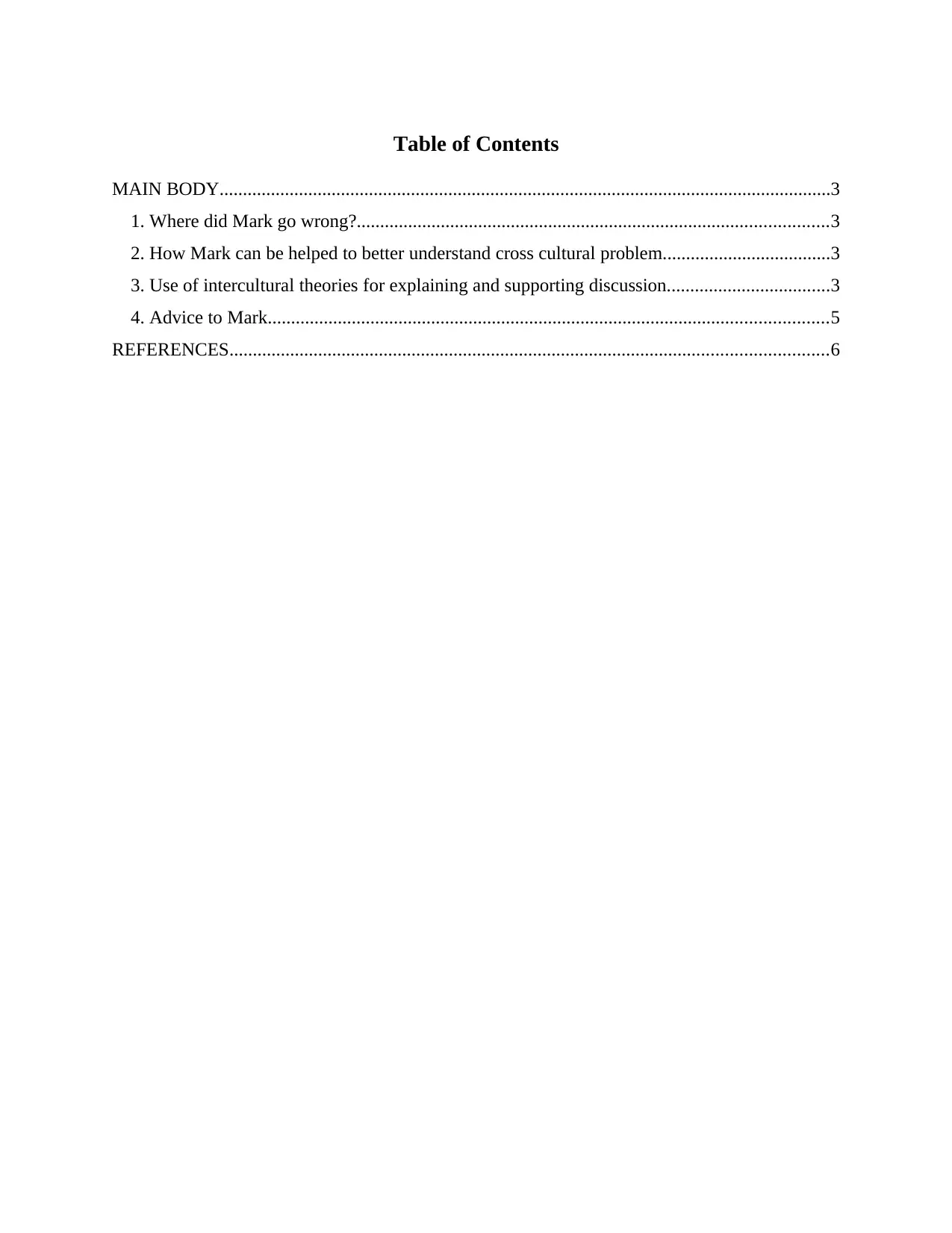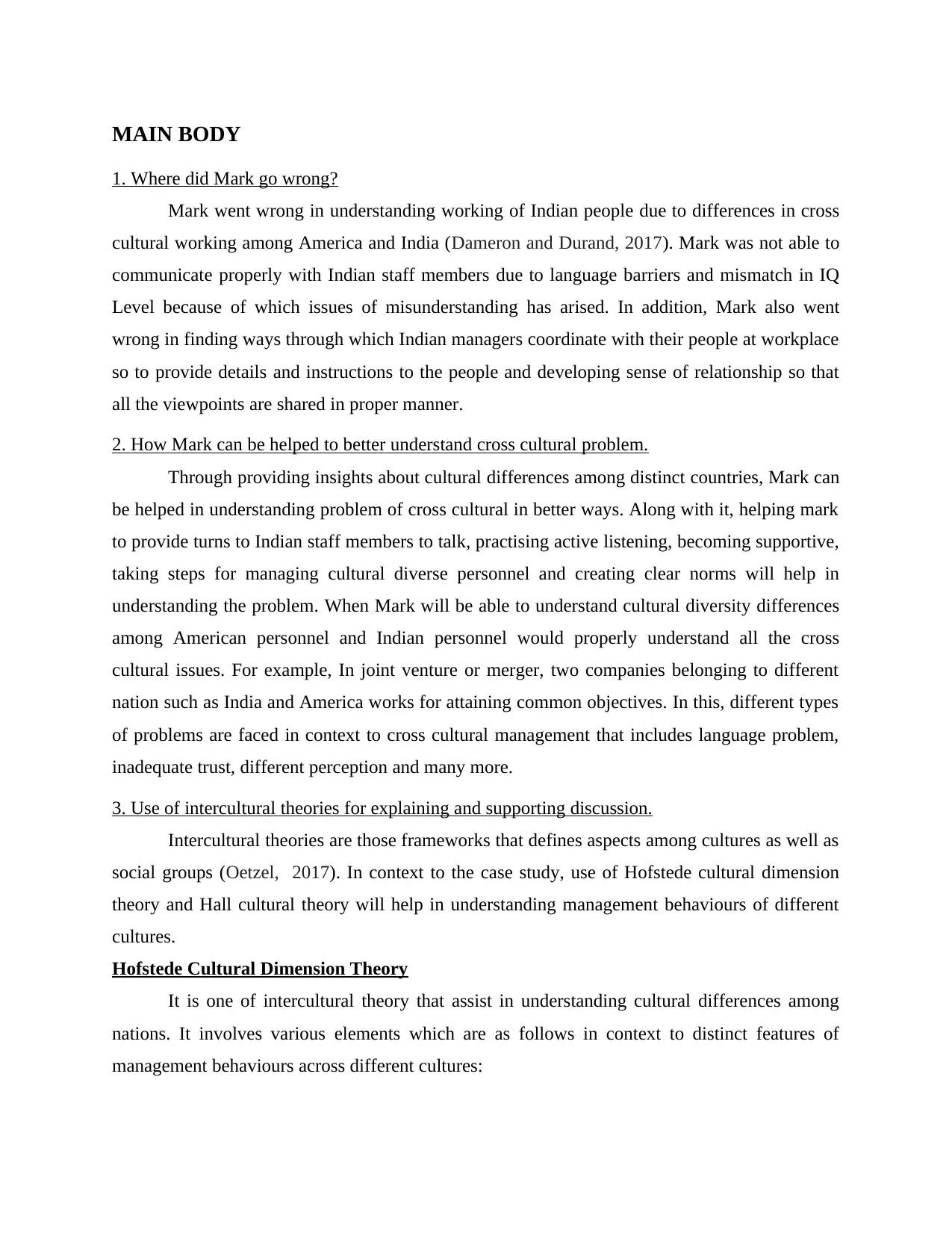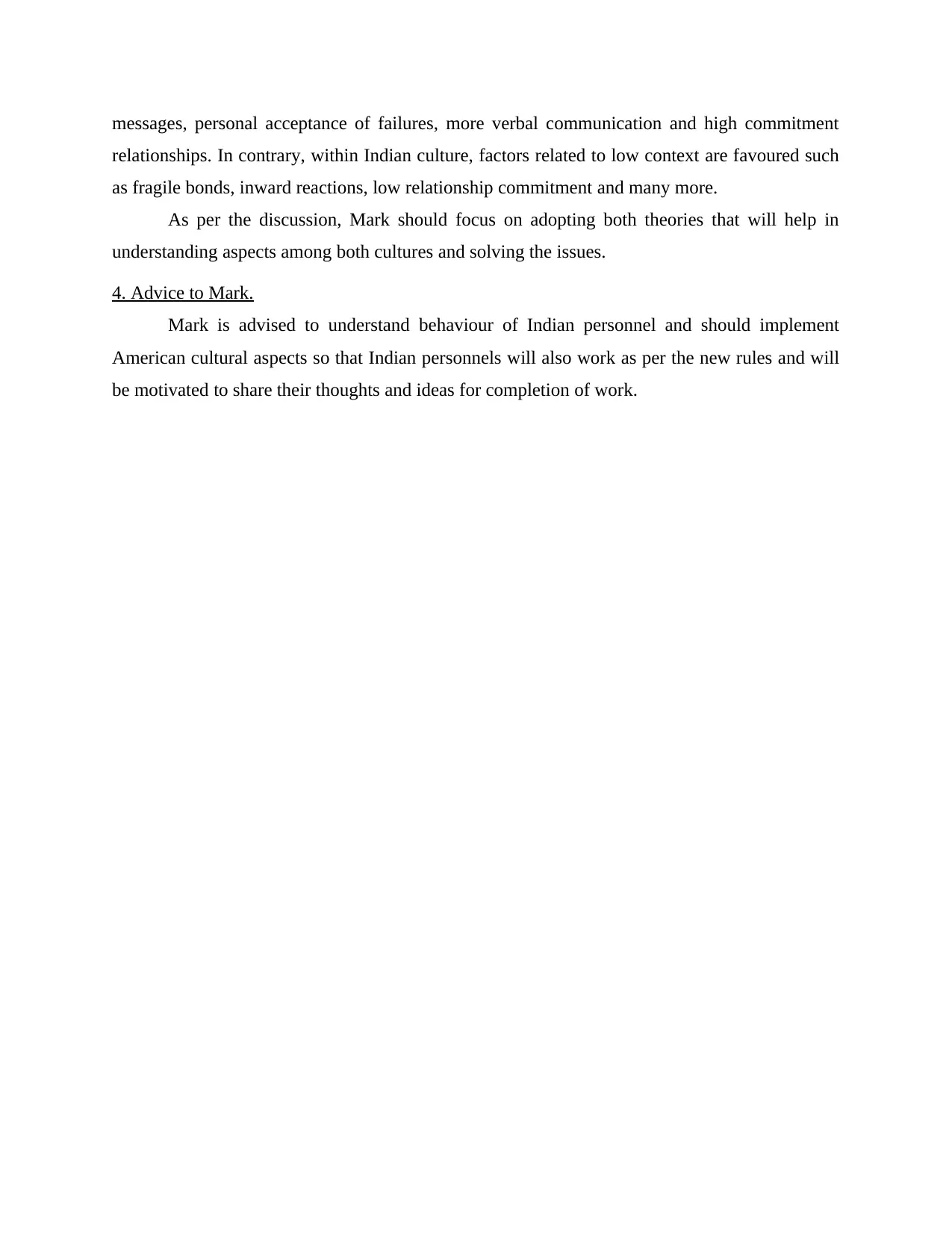Intercultural Management: Case Study and Recommendations
VerifiedAdded on 2023/01/16
|6
|1040
|54
Report
AI Summary
This report provides an analysis of intercultural management challenges based on a case study involving cross-cultural differences between American and Indian work environments. It identifies the mistakes made by Mark, a manager, in understanding the cultural nuances and communication styles of his Indian staff. The report explores how Mark can improve his understanding by providing insights into cultural differences, encouraging active listening, and managing cultural diversity. It utilizes intercultural theories, including Hofstede's cultural dimension theory and Hall's cultural theory, to explain management behaviors across cultures, focusing on power distance, individualism, uncertainty avoidance, and context. The report offers specific advice to Mark, emphasizing the importance of understanding Indian personnel behavior and implementing American cultural aspects to foster better communication and collaboration. The report is well-structured, referencing relevant books and journals to support the analysis.

Intercultural management
Paraphrase This Document
Need a fresh take? Get an instant paraphrase of this document with our AI Paraphraser

Table of Contents
MAIN BODY...................................................................................................................................3
1. Where did Mark go wrong?.....................................................................................................3
2. How Mark can be helped to better understand cross cultural problem....................................3
3. Use of intercultural theories for explaining and supporting discussion...................................3
4. Advice to Mark........................................................................................................................5
REFERENCES................................................................................................................................6
MAIN BODY...................................................................................................................................3
1. Where did Mark go wrong?.....................................................................................................3
2. How Mark can be helped to better understand cross cultural problem....................................3
3. Use of intercultural theories for explaining and supporting discussion...................................3
4. Advice to Mark........................................................................................................................5
REFERENCES................................................................................................................................6

MAIN BODY
1. Where did Mark go wrong?
Mark went wrong in understanding working of Indian people due to differences in cross
cultural working among America and India (Dameron and Durand, 2017). Mark was not able to
communicate properly with Indian staff members due to language barriers and mismatch in IQ
Level because of which issues of misunderstanding has arised. In addition, Mark also went
wrong in finding ways through which Indian managers coordinate with their people at workplace
so to provide details and instructions to the people and developing sense of relationship so that
all the viewpoints are shared in proper manner.
2. How Mark can be helped to better understand cross cultural problem.
Through providing insights about cultural differences among distinct countries, Mark can
be helped in understanding problem of cross cultural in better ways. Along with it, helping mark
to provide turns to Indian staff members to talk, practising active listening, becoming supportive,
taking steps for managing cultural diverse personnel and creating clear norms will help in
understanding the problem. When Mark will be able to understand cultural diversity differences
among American personnel and Indian personnel would properly understand all the cross
cultural issues. For example, In joint venture or merger, two companies belonging to different
nation such as India and America works for attaining common objectives. In this, different types
of problems are faced in context to cross cultural management that includes language problem,
inadequate trust, different perception and many more.
3. Use of intercultural theories for explaining and supporting discussion.
Intercultural theories are those frameworks that defines aspects among cultures as well as
social groups (Oetzel, 2017). In context to the case study, use of Hofstede cultural dimension
theory and Hall cultural theory will help in understanding management behaviours of different
cultures.
Hofstede Cultural Dimension Theory
It is one of intercultural theory that assist in understanding cultural differences among
nations. It involves various elements which are as follows in context to distinct features of
management behaviours across different cultures:
1. Where did Mark go wrong?
Mark went wrong in understanding working of Indian people due to differences in cross
cultural working among America and India (Dameron and Durand, 2017). Mark was not able to
communicate properly with Indian staff members due to language barriers and mismatch in IQ
Level because of which issues of misunderstanding has arised. In addition, Mark also went
wrong in finding ways through which Indian managers coordinate with their people at workplace
so to provide details and instructions to the people and developing sense of relationship so that
all the viewpoints are shared in proper manner.
2. How Mark can be helped to better understand cross cultural problem.
Through providing insights about cultural differences among distinct countries, Mark can
be helped in understanding problem of cross cultural in better ways. Along with it, helping mark
to provide turns to Indian staff members to talk, practising active listening, becoming supportive,
taking steps for managing cultural diverse personnel and creating clear norms will help in
understanding the problem. When Mark will be able to understand cultural diversity differences
among American personnel and Indian personnel would properly understand all the cross
cultural issues. For example, In joint venture or merger, two companies belonging to different
nation such as India and America works for attaining common objectives. In this, different types
of problems are faced in context to cross cultural management that includes language problem,
inadequate trust, different perception and many more.
3. Use of intercultural theories for explaining and supporting discussion.
Intercultural theories are those frameworks that defines aspects among cultures as well as
social groups (Oetzel, 2017). In context to the case study, use of Hofstede cultural dimension
theory and Hall cultural theory will help in understanding management behaviours of different
cultures.
Hofstede Cultural Dimension Theory
It is one of intercultural theory that assist in understanding cultural differences among
nations. It involves various elements which are as follows in context to distinct features of
management behaviours across different cultures:
⊘ This is a preview!⊘
Do you want full access?
Subscribe today to unlock all pages.

Trusted by 1+ million students worldwide

Power distance Index: The element considers extent at which power as well as
inequality are tolerated within business. In context to American Culture, managers have
behaviours for low power distance as they encourage decision making responsibility, power
distribution and many more. Where as within Indian Culture, management behaviours is for
preferring high power distance as they encourages inequality, differences and authority.
Collectivism and Individualism: The element focuses on integration of groups
(Rozkwitalska, Sułkowski and Magala, 2017). Within management behaviours of American
culture, collectivism is favoured as greater importance are placed on organisational goals. Where
as management behaviours of Indian culture. Individualism is more favoured for attaining
personal goals.
Uncertainty avoidance Index: The element focuses on toleration of uncertainness and
ambiguity. In relevance to Indian Culture, high uncertainty index is preferred for not accepting
any unknown situations. In context to American Culture, managers prefers low uncertainty index
as they welcomes or accepts unknown situations.
Femininity and Masculinity: The element is associated with preferences of achieving
society and attitudes towards sexual behaviours. At Indian Culture, managers focuses on
masculinity where as in American culture, more gender equality in which considerations are on
both indexes.
Short term and Long term orientation: The dimension emphasis on extent of social
views for time horizon. Within American culture, Long term orientation is focused by managers
for long term growth but in Indian Culture, short term orientation is favoured by managers.
Restraint and Indulgence: The dimension elaborates fulfilment of desires. At American
Culture, managers have behaviour for indulgence in which free gratitude is provided. Where as
within Indian Culture, managers behaviours to implement restraint index that suppresses
gratifications for needs of personnels.
Hall's Theory
The theory was propounded by Edward T. Hall who further classified it into low context
and high context. In Low context, major emphasis is on more verbal communication, less
misunderstanding and more straightforward answers (Tjosvold, 2017). In high context, Major
emphasis is on more non verbal communication, more confusions and many more aspects. At
American culture, managers focuses on adopting high context factors related to explicit
inequality are tolerated within business. In context to American Culture, managers have
behaviours for low power distance as they encourage decision making responsibility, power
distribution and many more. Where as within Indian Culture, management behaviours is for
preferring high power distance as they encourages inequality, differences and authority.
Collectivism and Individualism: The element focuses on integration of groups
(Rozkwitalska, Sułkowski and Magala, 2017). Within management behaviours of American
culture, collectivism is favoured as greater importance are placed on organisational goals. Where
as management behaviours of Indian culture. Individualism is more favoured for attaining
personal goals.
Uncertainty avoidance Index: The element focuses on toleration of uncertainness and
ambiguity. In relevance to Indian Culture, high uncertainty index is preferred for not accepting
any unknown situations. In context to American Culture, managers prefers low uncertainty index
as they welcomes or accepts unknown situations.
Femininity and Masculinity: The element is associated with preferences of achieving
society and attitudes towards sexual behaviours. At Indian Culture, managers focuses on
masculinity where as in American culture, more gender equality in which considerations are on
both indexes.
Short term and Long term orientation: The dimension emphasis on extent of social
views for time horizon. Within American culture, Long term orientation is focused by managers
for long term growth but in Indian Culture, short term orientation is favoured by managers.
Restraint and Indulgence: The dimension elaborates fulfilment of desires. At American
Culture, managers have behaviour for indulgence in which free gratitude is provided. Where as
within Indian Culture, managers behaviours to implement restraint index that suppresses
gratifications for needs of personnels.
Hall's Theory
The theory was propounded by Edward T. Hall who further classified it into low context
and high context. In Low context, major emphasis is on more verbal communication, less
misunderstanding and more straightforward answers (Tjosvold, 2017). In high context, Major
emphasis is on more non verbal communication, more confusions and many more aspects. At
American culture, managers focuses on adopting high context factors related to explicit
Paraphrase This Document
Need a fresh take? Get an instant paraphrase of this document with our AI Paraphraser

messages, personal acceptance of failures, more verbal communication and high commitment
relationships. In contrary, within Indian culture, factors related to low context are favoured such
as fragile bonds, inward reactions, low relationship commitment and many more.
As per the discussion, Mark should focus on adopting both theories that will help in
understanding aspects among both cultures and solving the issues.
4. Advice to Mark.
Mark is advised to understand behaviour of Indian personnel and should implement
American cultural aspects so that Indian personnels will also work as per the new rules and will
be motivated to share their thoughts and ideas for completion of work.
relationships. In contrary, within Indian culture, factors related to low context are favoured such
as fragile bonds, inward reactions, low relationship commitment and many more.
As per the discussion, Mark should focus on adopting both theories that will help in
understanding aspects among both cultures and solving the issues.
4. Advice to Mark.
Mark is advised to understand behaviour of Indian personnel and should implement
American cultural aspects so that Indian personnels will also work as per the new rules and will
be motivated to share their thoughts and ideas for completion of work.

REFERENCES
Books and Journals:
Dameron, S. and Durand, T. eds., 2017. The Future of Management Education: Volume 1:
Challenges Facing Business Schools Around the World. Springer.
Oetzel, J. G., 2017. Effective intercultural workgroup communication theory. The International
Encyclopedia of Intercultural Communication, pp.1-5.
Rozkwitalska, M., Sułkowski, Ł. and Magala, S., 2017. Intercultural Interactions in the
Multicultural Workplace. Springer International Publishing, Switzerland.
Tjosvold, D., 2017. Cross-cultural management: foundations and future. Routledge.
Books and Journals:
Dameron, S. and Durand, T. eds., 2017. The Future of Management Education: Volume 1:
Challenges Facing Business Schools Around the World. Springer.
Oetzel, J. G., 2017. Effective intercultural workgroup communication theory. The International
Encyclopedia of Intercultural Communication, pp.1-5.
Rozkwitalska, M., Sułkowski, Ł. and Magala, S., 2017. Intercultural Interactions in the
Multicultural Workplace. Springer International Publishing, Switzerland.
Tjosvold, D., 2017. Cross-cultural management: foundations and future. Routledge.
⊘ This is a preview!⊘
Do you want full access?
Subscribe today to unlock all pages.

Trusted by 1+ million students worldwide
1 out of 6
Related Documents
Your All-in-One AI-Powered Toolkit for Academic Success.
+13062052269
info@desklib.com
Available 24*7 on WhatsApp / Email
![[object Object]](/_next/static/media/star-bottom.7253800d.svg)
Unlock your academic potential
Copyright © 2020–2025 A2Z Services. All Rights Reserved. Developed and managed by ZUCOL.





